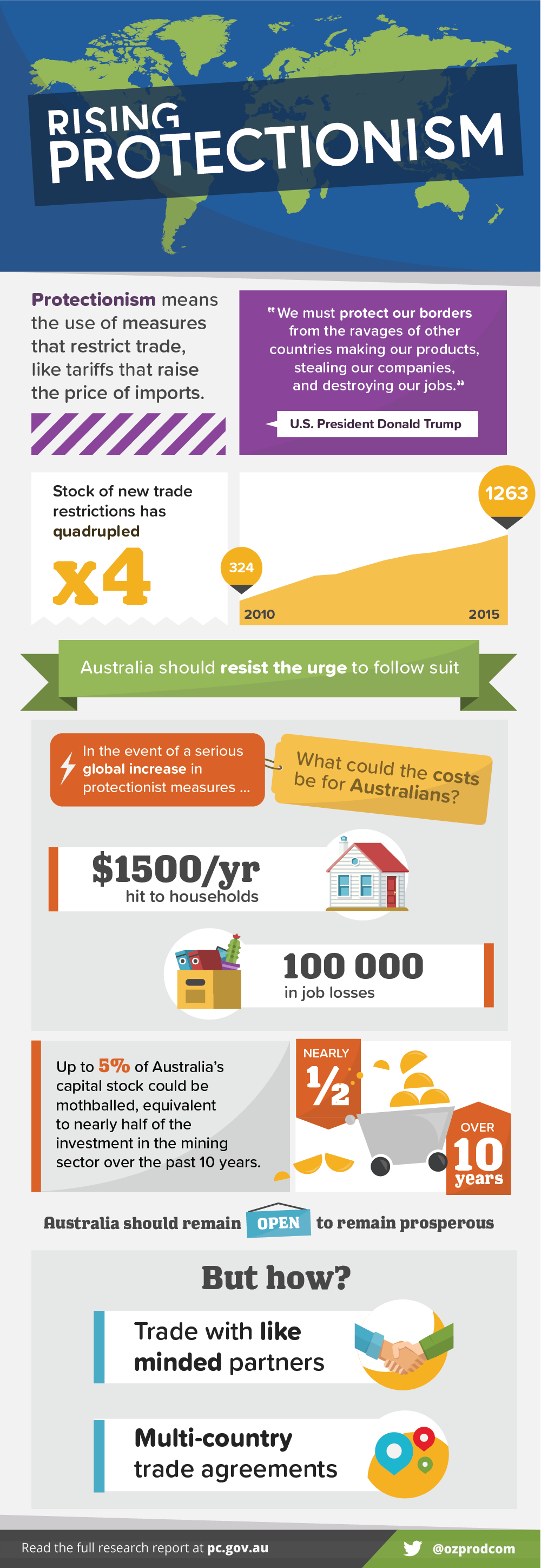Rising protectionism: Challenges, threats and opportunities for Australia
Commission research paper
This research paper was released on 19 July 2017 and outlines a three pronged strategy that would help achieve better outcomes for all Australians and foster public confidence in open markets.
Download the paper
- Rising Protectionism: Challenges, threats and opportunities for Australia (PDF - 1312 Kb)
- Rising Protectionism: Challenges, threats and opportunities for Australia (Word - 1125 Kb)
Technical paper: Modelling Protectionist Trade Policies
This technical paper supports the Commission's research report, Rising Protectionism: challenges, threats and opportunities for Australia. It documents the modelling undertaken to illustrate the economic effects of potential changes in the trade environment facing Australia.
The paper has three sections. Section 1 outlines the modelled scenarios. Section 2 summarises the features of the models used for the project, and explains how the choice of closure assumptions can affect model results. Section 3 contains an analysis of the scenarios modelled.
The modelling is available on request from the Productivity Commission in the form of zip files that allow the results to be reproduced and analysed in more detail.
- Infographic
- Media release
- Contents
Infographic: Rising Protectionism
Download the infographic

Rising Protectionism (Text version of infographic)
Protectionism means the use of measures that restrict trade, like tariffs that raise the price of imports.
'We must protect our borders from the ravages of other countries making our products, stealing our companies, and destroying our jobs.'
- U.S. President Donald Trump
Stock of new trade restrictions has quadrupled: 324 in 2010 and 1263 in 2015.
Australia should resist the urge to follow suit.
In the event of a serious global increase in protectionist measures…
What could the costs be for Australians?
- $1500/yr hit to households
- 100 000 in job losses
Up to 5% of Australia's capital stock could be mothballed, equivalent to nearly half of the investment in the mining sector over the past 10 years.
Nearly half over 10 years.
Australia should remain open to remain prosperous.
But how?
- Trade with like minded partners
- Multi-country trade agreements
Read the full research report.
Protectionist trade policies bad for Australia
The Productivity Commission's Commission-initiated research report Rising protectionism: challenges, threats and opportunities for Australia models a set of scenarios based on new US trade policies and seeks to identify their implications for Australia.
Implications for the US and other nations are also captured by the modelling. Interestingly, the US is not made better off by lifting tariff walls.
For Australian policy-makers, the conclusion is simple and strongly supported by both experience and data: resist the call to join protectionist trade policies, even in the event of a global outbreak of protectionism. Continue to work towards freer markets, with like-minded nations.
In the event of a serious global reversal of the long term decline in protectionist measures, the Commission estimates that the average household would be worse off by nearly $1500 a year.
Close to 100 000 jobs could be lost.
Up to 5 per cent of Australia's capital stock could be mothballed, equivalent to nearly half of the investment in the mining sector over the past 10 years.
Australia should prioritise regional trade agreements that clearly and measurably persist with lowering barriers to all trading partners; and reinforce efforts to strengthen the rules-based trade system.
Aligned with this, better engagement with the community to put clearly the gains that have been delivered by removing barriers to international competition and action to build upon our undoubtedly strong social adjustment practices, are essential complements to remaining an open and prospering participant in the international trading system.
- Cover, Copyright and publication details
- Executive summary
- Conclusions
- Chapter 1 A changing trade policy landscape
- 1.1 Why this study?
- 1.2 Australia's trade and investment at a glance
- 1.3 The research approach
- Chapter 2 Higher US tariffs on imports from China and Mexico
- 2.1 US threats of higher tariffs and potential retaliation
- 2.2 Trade relationships between China, Mexico, the United States and Australia
- 2.3 How might Australia be affected if the United States raises tariffs on imports from China and Mexico?
- Chapter 3 Trade effects of border adjustments
- 3.1 The DBCFT system
- 3.2 Possible impacts of border adjustments
- Chapter 4 The risks of global contagion
- 4.1 Evidence of recent rises in protectionism
- 4.2 How might Australia be affected by global increases in protection?
- 4.3 How would Australian households be affected?
- Chapter 5 The benefits of further liberalisation
- 5.1 What might a regional coalition look like?
- 5.2 How might Australia be affected by regional co-operation?
- Chapter 6 Where to for Australia
- 6.1 Is there a case for a policy rethink?
- 6.2 Continue to work towards freer markets
- 6.3 A better rules-based trade system
- 6.4 Making trade work for all
- 6.5 Better engagement with the community
- References
Printed copies
This publication is only available online.
Publications feedback
We value your comments about this publication and encourage you to provide feedback.